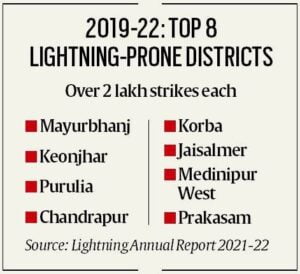Geography
Context: Several deaths are being reported due to lightning across India
- Seventeen people have been killed by lightning over the last two days in various parts of Bihar
- Of all the atmospheric phenomena, lightning perhaps is the most dangerous and mysterious.
- In India, lightning kills about 2,000-2,500 people every year.
What is lightning?
- Scientifically, lightning is a rapid and massive discharge of electricity in the atmosphere some of which is directed towards earth.
- The discharges are generated in giant moisture-bearing clouds that are 10-12 km tall.
- The base of these clouds typically lies within 1-2 km of the Earth’s surface, while the top is 12-13 km away.
- Temperatures in the top of these clouds are in the range of –35° to –45°C.
- As water vapour moves upward in the cloud, the falling temperature causes it to condense.
- As they move to temperatures below 0°C, the water droplets change into small ice crystals.
- They continue to move up, gathering mass until they are so heavy that they start to fall to Earth.
- This leads to a system in which, simultaneously, smaller ice crystals are moving up and bigger crystals are coming down.
- Collisions follow and trigger the release of electrons, a process that is very similar to the generation of sparks of electricity.
- As the moving free electrons cause more collisions and more electrons, a chain reaction ensues.
- This process results in a situation in which the top layer of the cloud gets positively charged, while the middle layer is negatively charged.
- The electrical potential difference between the two layers is huge, of the order of a billion to 10 billion volts.
- In very little time, a massive current, of the order of 100,000 to a million amperes, starts to flow between the layers.
- While the Earth is a good conductor of electricity, it is electrically neutral.
- However, in comparison to the middle layer of the cloud, it becomes positively charged.
- As a result, about 15%-20% of the current gets directed towards the Earth as well.
- It is this flow of current that results in damage to life and property on Earth.
- Direct lightning strikes are rare but even indirect strikes are fatal given the immense amount of charge involved.
Which areas are lightning-prone?
- A recently released annual report on lightning by the Climate Resilient Observing Systems Promotion Council (CROPC), which works closely with government agencies like the India Meteorological Department, includes a lightning atlas which maps vulnerability at the district level.
- According to the report, Madhya Pradesh has reported the largest number of cloud to ground lighting strikes, followed by Chhatisgarh, Maharashtra, Odisha and West Bengal.
- Other states with high strike rate include Bihar, UP, Karnataka, Jharkhand and Tamil Nadu
- In 2019-20, about 1.4 crore lightning strikes were recorded, which increased to 1.85 crore in 2020-21.
- In 2021-22, about 1.49 crore strikes were recorded across the country.
- The reduction, in line with the trend observed globally, has been attributed to the impact of the Covid-19 pandemic.
- The reason attributed to reduction in lightning is due to Covid-2019 pandemic induced reduction in aerosol level, pollution, environmental upgradation and relatively stable weather system in Indian subcontinent

How can the effects of lightning strikes be mitigated?
- Lightning is not classified as a natural disaster in India.
- But recent efforts have resulted in the setting up of an early warning system that is already saving many lives.
- More than 96% of lightning deaths happen in rural areas.
- As such, most of the mitigation and public awareness programmes need to focus on these communities.
- Lightning protection devices are fairly unsophisticated and low-cost. Yet, their deployment in the rural areas, as of now, is extremely low.
- States are being encouraged to prepare and implement lightning action plans, on the lines of heat action plans.
Source: Indian Express
Previous Year Question
Q.1) During the thunderstorm, the thunder in the skies is produced by the (2013)
- meeting of cumulonimbus clouds in the sky
- lightning that separates the nimbus clouds
- violent upward movement of air and water particles
Select the correct answer using the codes given below.
- 1 only
- 2 and 3
- 1 and 3
- None of the above produces the thunder














